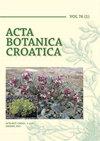Pollen morphology and flower visitors of Leiotulus aureus (Sm.) Pimenov & Ostr. (Apiaceae)
IF 0.7
4区 生物学
Q3 PLANT SCIENCES
引用次数: 0
Abstract
The pollen grains of Leiotulus aureus (syn. Malabaila aurea (Sm.) Boiss.) were examined by light and scanning electron microscopy in order to contribute to the taxonomical and melissopalynological studies of the species. Flower visitors have also been observed and analyzed aiming at clarifying some pollination aspects including the species contribution to the bee pasture. The pollen grains of L. aureus are isopolar, radially symmetrical, medium to large in size, tricolporate and perprolate. They are slightly equatorially constricted with obtuse polar caps and triangular in polar view. The sculpturing pattern is rugulate–microperforate. With regard to flower visitors, the following pollination types occurred: melittophily, myophily and sapromyophily and cantharophily. Some insects attracted by L. aureus cannot be considered pollinators but casual visitors. The flowers were the most frequently visited by honey bees during the midday.金黄色花(Leiotulus aureus(Sm.)Pimenov和Ost。(Apiaceae)
金黄色花的花粉粒(syn.Malabailaaurea(Sm.)Boiss.)通过光镜和扫描电子显微镜进行了检查,以便为该物种的分类和花粉学研究做出贡献。还对访花者进行了观察和分析,旨在澄清一些授粉方面,包括物种对蜜蜂牧场的贡献。金黄色葡萄球菌的花粉粒为等极性,径向对称,大小中等至较大,三孔和全孔。它们有轻微的等轴颈缩,有钝的极帽,在极视图中呈三角形。雕刻图案是褶皱的——微穿孔。就访花者而言,出现了以下授粉类型:喜花授粉、喜花授粉和无花授粉以及喜角授粉。一些被金黄色葡萄球菌吸引的昆虫不能被视为传粉昆虫,而是偶然的访客。这些花是蜜蜂在中午最常去的地方。
本文章由计算机程序翻译,如有差异,请以英文原文为准。
求助全文
约1分钟内获得全文
求助全文
来源期刊

Acta Botanica Croatica
PLANT SCIENCES-
CiteScore
2.50
自引率
0.00%
发文量
34
审稿时长
>12 weeks
期刊介绍:
The interest of the journal is field (terrestrial and aquatic) and experimental botany (including microorganisms, plant viruses, bacteria, unicellular algae), from subcellular level to ecosystems. The attention of the Journal is aimed to the research of karstic areas of the southern Europe, karstic waters and the Adriatic Sea (Mediterranean).
 求助内容:
求助内容: 应助结果提醒方式:
应助结果提醒方式:


